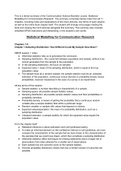Summary
SMCR Mastery Summary
- Course
- Institution
This is a dense summary of the Communication Science Bachelor course, Statistical Modelling for Communication Research. The summary comprises dense notes from all 11 chapters, including notes and explanations of the micro-lectures, key terms of each session, as well as the entire book chapter itsel...
[Show more]



